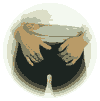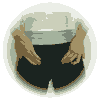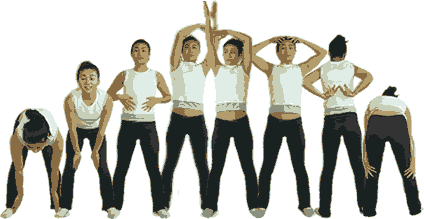Many of us live somewhat sedentary lives — tied to a computer, office or some repetitive task. Even if we exercise, our movements tend to be somewhat restricted — we move our bodies in routine or habitual ways.
The sheer range of unusual movements made in a practice such as yoga, tai chi or feldenkrais can be wonderful for the body. After such practices, the body usually feels looser, lighter and energised. However, you don’t need to attend a class or engage in formal practice to benefit from such movements. You can do them at your desk, as you walk, even in front of the TV. In fact, we all stretch, rub and massage our bodies quite naturally. Such natural tendencies are the basis for the following series of movement meditations.
These can be used individually throughout the day to help keep the body relaxed and open. As a sequence, they can also be useful to do prior to a formal ‘sitting’ practise.
1. Shake Your Sillies Out
This one, I must warn you, comes straight from Play School (I’ve always maintained that we learn the most useful stuff in kindergarten) — and you might feel a little silly doing it. Ultimately though, who cares, if it can help you to feel more relaxed?
How to do it
Simply shake your body. I like to start with the hands, then move up through the forearms and upper arms to the shoulders. I add in the torso, then one leg, then the other — and I shake everything with the intention of getting it to feel as floppy and jelly-like as possible.
More info
While writing the instructions above I did a Google search for ‘Shake Your Sillies Out’, hoping to find an appropriate image to illustrate the technique. Interestingly, I found a whole site dedicated to ‘Brain Wave Vibration’, a modality based on this one technique. Included is a nice little article on Shaking Your Sillies Out, as well as a You Tube infomercial, which isn’t so bad. Or, get right into the spirit of it by singing along with The Wiggles.
2. Joint Rotations
If you think of your body as a city-like network of arteries and veins distributing blood, oxygen and energy — then the joints could be seen as the major intersections. As such, they’re the places where you might get traffic jams. It the city, you often have to wait to clear such blockages. In the body however, you just have to move them.
Rotations facilitate flexibility and energy flow by lubricating the entire joint with synovial fluid. And you’ll be pleased to know that the idea for Joint Rotations comes, not from Play School, but from principles of stretching and flexibility commonly used by athletes to warm up.
How to do it
Start either from your toes and work your way up, or from your fingers and work your way down. Ideally, do slow circular movements, both clockwise and counter-clockwise, until the joint seems to move smoothly.
- fingers and knuckles
- wrists
- elbows
- shoulders
- neck
- trunk/waist
- hips
- legs
- knees
- ankles
- toes
3. Tai Chi Swing
From the joints we move to the spine, which can also become somewhat rigid and inflexible. A favourite with golfers, do this one for a minute or so when you get up after you’ve been driving or sitting.
How to do it
Stand with feet shoulder width apart. Rest your attention in the centre of the body — just below and behind the navel — and allow your body to rotate around this point, letting the arms swing freely and relaxing the shoulders.
More info
Here’s a You Tube video to illustrate the Tai Chi Swing. It includes numerous variations.
4. Shoulder Shrug
A simple technique to address and help release tension in the neck and shoulders. Done in combination with deep, slow breaths, this can be particularly useful as a means to calm the over-active or anxious mind prior to exams, presentations and other stressful situations.
How to do it
- Raise your shoulders towards the ears as you inhale deeply.
- Hold the breath momentarily as you roll the shoulders back, allowing the collar bones to stretch out and back.
- Allow the shoulders to drop as you exhale slowly through the mouth.
- Repeat three times, then stand quietly, imagining weights (attached to the fingers) gently pulling downwards on the shoulders.
5. Power Points
Perhaps the kookiest of these movement meditations, it’s also one of the most popular and effective. In contrast to the movements described above, this one is used to clear and energise the mind, rather than to calm and settle it.
How to do it
Using fingers make firm circular movements at the following points.
| Forehead | Kidney Points | Groin | |||
|---|---|---|---|---|---|
 |
Rub just above and between eyebrows with fingertips. |  |
Rub hollows just below collar bone. Note: If painful drink water. |
 |
Rub hollows in groin. |
| Occipital Lobes | Buttocks | ||||
 |
Rub occipital lobes. |  |
Rub sitting bones. | ||
6. Yin/Yang massage
Based upon the concept of meridians used in Acupuncture and Traditional Chinese Meditation, this is another movement designed to energise the body.
How to do it
The idea is to follow and reinforce the natural flow of energy through the body — down the outer / back (Yang) of the body and back up the inner / front (Yin) surface of the body. You can start with either the front or the back of the body, working up from the feet or down from the raised arms. In the instructions below we start from the feet and work up.
- Stand with feet shoulder width apart. Feel your connection to the Earth (Yin Energy) through the soles of your feet.
- Bending from the hips reach down to the inner aspect of the feet.
- Sweep upwards with your hands along the inner (Yin) side of the legs
- Continue upwards, moving the hands up the front of the torso
- Then brush upwards along the inner surface of each arm.
- Hold arms aloft momentarily, imagining you are reaching for the sun. (Yang Energy)
- Brush downwards along the outer surface of each arm
- Brush your hands back across your head from just above the eyes and down to the back of the neck
- Then reach behind your back and brush your hands downwards either side of the spine and over the buttocks
- Continue brushing down the legs. Wrap your hands around your legs so that your thumb is positioned at the front and your little finger at the back so that you cover the front, outer aspect and back of the legs.
- Finish at the tip of the little toe.
- Hold position momentarily and then repeat. Sweep up and down the entire body in this manner three times (or more if you like).


7. Meridian Tapping
An alternative, perhaps even more effective that the yin-yang massage.
Starting with one arm or the other proceed to tap gently with the palm along the inside, top, outside and bottom of each arm. Repeat on the other arm, and then proceed down the front, outside, back and insides of both legs simultaneously.
8. Neck Massage
Another one for the neck. Simply interlace your fingers and place your hands behind your head. You’ll find that you can point your thumbs downward and use them to gently rub either side of the cervical spine. Alternatively you can use one hand to do this, grabbing yourself by the scruff of the neck as a cat would its kittens, and massaging one side, then the other, with the fingers.
9. Eye Exercises
Most of us recognise that the body benefits from exercise, but I suspect few of us include our eyes in any fitness regime. There are numerous eye exercises that have been developed to minimise eyestrain and even to help prevent the deterioration of your eyesight. You don’t have to do all the following; just try and use the exercises you prefer.
How to do it
- Rub your hands together until they feel warm, then close your eyes and cover them lightly with your cupped palms.
- Close your eyes tightly for 3-5 seconds, then open them for 3-5 seconds.
- Close your eyes and massage them with circular movements, pressing very lightly.
- Press three fingers of each hand against your upper eyelids, and hold them there for 1-2 seconds, then release.
- Roll your eyes clockwise, then counter-clockwise (or make figure-of-eights). Repeat 5 times, and blink in between each time.
- Focus on something far away for 10-15 seconds; then focus on something near.
- Look in front of you at the opposite wall and pretend that you are writing with your eyes, without turning your head. It may seem difficult at first, but with a bit of practice it is really fun. The bigger the letters, the better the effect.
10. Progressive Muscle Relaxation (For the Face)
Perhaps you’re familiar with PMR, the technique in which you sequentially tense and then relax each part of the body. Here’s a version just for the face. Basically, you just have to imitate the man below, by concentrating on the tip of your nose and endeavouring to get everything from chin to crown and ear to ear to meet in the middle.

11. Make Your Own Up
What’s most important in all the above, is not following the instructions accurately, but simply paying attention to the way your own body feels, listening to it and treating it gently and kindly. Does it need water? Food? Touch? How could you meet these needs now? Could your body be softer, warmer, more relaxed, more open?
Ask these questions regularly of your body and come up with your own answers. One thing I really like doing for my body is 5 Element Qi Gong. Yes, it sounds and looks weird to a Westerner, but it’s standard for almost anyone in China. For some simple Qi Gong movements see local Qi Gong Master Liu Deming in action on You Tube.
